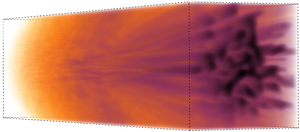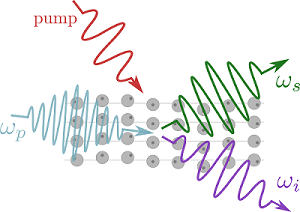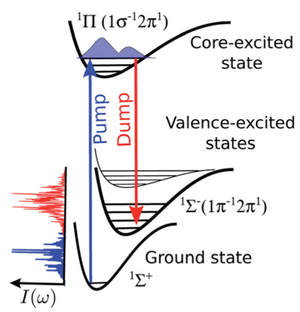Research
X-rays are electromagnetic radiation in a wavelength regime spanning from several 10 nm down to 0.01 nm. Their wavelength is matching the typical length scale of interatomic distances in molecules and solids. Thus, x-rays are a formidable probe of the structure of matter on the atomic scale. The interaction of x-rays with matter is relatively weak and they penetrate matter with only little interaction. This makes them attractive to study bulk matter (in contrast to surfaces). Due to their low interaction cross sections with matter, the majority of x-ray based techniques rely on the linear interaction of matter. In technical terms this means, that their interaction with the electrons of the material can be understood by applying first order perturbation theory in the interaction with the electromagnetic field. In the XXI century, a new chapter in x-ray science was initiated with the advent of X-ray Free Electron Lasers (XFELs). XFELs are the brightest laboratory-based x-ray sources, providing pulses of femtosecond duration and surpassing achievable intensities at storage-ring based x-ray sources by 10 orders of magnitude. Their short pulses open the pathway to study electron and nuclear dynamics on their natural timescale. Their high intensity enables the study of nonlinear interaction with matter, which might be exploited for novel powerful x-ray measurement techniques of the structural dynamics of matter.
In our group, we focus on the development of theoretical and numerical methods to describe the nonlinear interaction of x-rays with matter, ranging from single atoms, small molecules and atomic nanometer-sized clusters to solid-state systems. The trade mark of the group is its close link to experiments. In particular, we suggest novel experimental methods, exploit their feasibility by nearly start-to-end simulations of the experiments and engage in the demonstration of these novel techniques in collaboration with experimental partners. Our portfolio of projects encompasses:
Inner-shell x-ray lasing

Construction of an x-ray laser was a dream starting from the 1960-s. Starting from 2010-s, XFEL facilities provide x-ray pulses that are short and intense, but the randomness inherent to the noise amplification concept of XFELs results in poor stability and low longitudinal coherence. The XFEL pulse can be used as a pump for inner-shell transition, e.g. to create a hole in the 1s shell and in this way produce population inversion between 2p and 1s shells, thus leading to laser-like amplification of the x-ray fluorescent radiation. This was demonstrated in the pioneering experiment by Nina Rohringer in 2011 …. Read more
Nonlinear x-ray processes

With the advent of increasingly powerful x-ray sources, opportunities arise to expand upon established (linear) techniques by combining multiple processes of light-matter interaction into novel non-linear schemes. Mixing x-rays and optical light fields - for instance - promises microscopic imaging capabilities similar to conventional x-ray diffraction yet with additional spectroscopic sensitivity. By merging these complementary features, access to important valence-electronic properties may be facilitated… Read more
Stimulated x-ray Raman scattering

Novel x-ray sources enable the transfer of methods from the optical domain to the x-ray domain. A prominent example is resonant inelastic x-ray scattering (RIXS) that addresses the valence excitations – in the same way as optical Raman scattering does for vibrational states. A stimulated version of it – stimulated x-ray Raman scattering – is possible with XFEL sources and could be a way towards tracking electronic coherences and conical intersections… Read more
X-ray scattering enhancement via transient resonances
The advent of X-ray Free Electron Lasers (XFELs) opened the way for ways of exploring and controlling non-linear light-matter interaction and collective emission phenomena. Exploiting the extreme intensity of XFEL and building upon well-established techniques - such as x-ray lasing and x-ray superfluorescence - we aim at controlling the scattering properties of individual atoms. The process starts with irradiation by an XFEL pump pulse that creates core transient resonances in a target atom via photoionization. A second probe pulse, whose energy is resonant with one of the opened inner-shell transitions, can scatter, experiencing an enhanced atomic scattering factor. Read more
The interests of the group are not limited to the projects described above. Moreover, we think that expertise accumulated in the group could also be applied beyond its origin. We are open to interdisciplinary discussions with researchers in other natural science disciplines – from mathematics to biology.